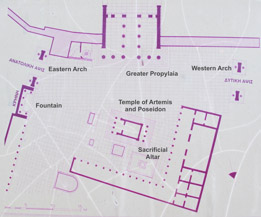SITE PLAN
|
|
|
|

|
||
|
|
|
|
| Eleusis: much of what can be seen is of the monumental architecture from Roman period of C2ndAD. | ||
|
|
|
|

|
||
|
|
|
|
| The Roman Courtyard, of grand dimensions typically found in public areas... | ||
|
|
|
|

|
||
|
|
|
|
| ... was begun by Hadrian and completed by Marcus Aurelius. | ||
|
|
|
|

|
||
|
|
|
|
| An eschara from the Roman period : a sacrificial brazier-altar for sacrifices to chthonic deities. | ||
|
|
|
|

|
||
|
|
|
|
| Remains of the Temple of Artemis and Poseidon built by Marcus Aurelius. | ||
|
|
|
|

|
||
|
|
|
|
| Doric frieze with triglyphs and metopes | ||
|
|
|
|

|
||
|
|
|
|
| Cornice of the Western Arch, once 16m high. | ||
|
|
|
|

|
||
|
|
|
|
| The lavishly decorated West Triumphal Arch marked the road from Megara. | ||
|
|
|
|

|
||
|
|
|
|
| The finds from buildings to the west, suggest they were the residences of priestly officials. | ||
|
|
|
|

|
||
|
|
|
|
|
|
|
|

|
||
|
|
|
|
| The house of the Kerykes: one of the two most important clans at Eleusis. | ||
|
|
|
|

|
||
|
|
|
|
| The house of the Kerykes: one of the two most important clans at Eleusis. | ||
|
|
|
|

|
||
|
|
|
|
| Silo storage for the first harvest of grain that was offered to Demeter by all ancient cities. | ||
|
|
|
|

|
||
|
|
|
|
| Silos to the West of the Propylaia date from the period of Peisistratos 561-527 BC. | ||
|
|
|
|

|
||
|
|
|
|
|
|
|
|

|
||
|
|
|
|
| The architrave was positioned by mortise and tenon. | ||
|
|
|
|

|
||
|
|
|
|
| Paving slabs were laid over foundations before the walls were built. | ||
|
|
|
|

|
||
|
|
|
|
| Stone chipped to hold plaster. | ||
|
|
|
|

|
||
|
|
|
|
|
|
|
|

|
||
|
|
|
|
| The Roman Forecourt before the Propylaia was bounded by the East and West Arches built by Antonius Pius. | ||
|
|
|
|

|
||
|
|
|
|
| The Eastern Arch. | ||
|
|
|
|

|
||
|
|
|
|
| Inscriptions show they were dedicated to Demeter and Persephone and to the Emperor Antonius. | ||
|
|
|
|

|
||
|
|
|
|
| Triumphal arches were erected to honour an emperor or commemorate victories or to mark a significant area, in this case the entrance to the Sanctuary. | ||
|
|
|
|

|
||
|
|
|
|
| Finds from this building testify to it being an Inn. The size of the Telestron and contemporary accounts ... | ||
|
|
|
|

|
||
|
|
|
|
| ...suggest that pilgrims travelled from far and wide to participate in the festivals. | ||
|
|
|
|

|
||
|
|
|
|
| Bath Houses like this one consisted of three rooms: frigidarium, tepidarium and caldarium. The brick columns identify the location of the hypocaust; two circular bath tubs are also preserved. | ||
|
|
|
|

|
||
|
|
|
|
| The fortified wall built by Kimon (470BC+/-) was thickened and strengthened by the Romans. | ||
The photographs on this site are for the use of the Participants of the Event and their Families and Friends and may be copied and printed for personal use only. Their use for commercial purposes is governed by copyright and permission must be obtained from the webmaster . Events-On-Line ~ (C) 2013


